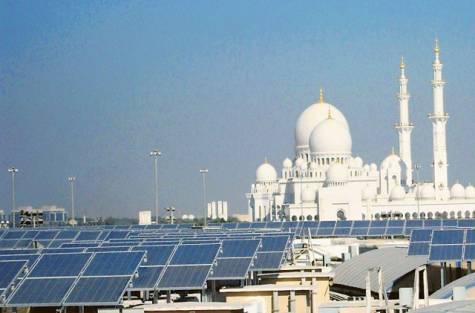The United Arab Emirates (UAE), despite its history as a major oil producing nation, is making major steps to become a solar leader as well. Despite its relatively small size, the UAE is one of the world’s top ten carbon emitters, so the UAE has environmental motivations to switch to solar as well as economic reasons.
Located on the Persian Gulf in the Arabian peninsula, the UAE holds the world’s 7th largest oil reserves. Slightly more socially progressive than some of its neighboring countries, the UAE prides itself on its technological modernity– just this week Abu Dhabi University launched a Masters of Science program in Sustainable Architecture. The UAE boasts the world’s busiest airport, a high-tech national rail network, and the region’s largest Concentrated Solar Power (CSP) generating station, the SHAMS 1, which utilizes a parabolic trough design to generate a nameplate capacity of 100 MW. In 2015, the UAE hosted the Abu Dhabi solar challenge. Sponsored by Abu Dhabi National Oil Company (ADNOC) and hosted by Masdar, Abu Dhabi’s renewable energy company, the solar car race was part of Abu Dhabi Sustainability Week. The first solar challenge competition held in the region, saw students from Australia, the Middle East, Europe, America and Asia compete in the cross-country road event. A team from Michigan University narrowly defeated the local favorite from the UAE Petroleum Institute.
 Masdar also has plans to build its own city in Abu Dhabi which, when completed, will be the most sustainable city in the world. Car-free and run on 100% renewable energy, Masdar City will be home to 45,000 people and attract an additional 60,500 daily commuters, who will arrive in part via a new rail line. Its design is rooted in the Arabic tradition of walled cities—but Masdar’s stone-and-mud walls will be covered in photovoltaic panels capable of generating 130 megawatts. Along the site’s northern edge, the walls will be more permeable to let in breezes. Electricity will also come from photovoltaic cells integrated into rooftops and a 20-megawatt wind farm. The city will get its water from a solar-powered desalination plant.
Masdar also has plans to build its own city in Abu Dhabi which, when completed, will be the most sustainable city in the world. Car-free and run on 100% renewable energy, Masdar City will be home to 45,000 people and attract an additional 60,500 daily commuters, who will arrive in part via a new rail line. Its design is rooted in the Arabic tradition of walled cities—but Masdar’s stone-and-mud walls will be covered in photovoltaic panels capable of generating 130 megawatts. Along the site’s northern edge, the walls will be more permeable to let in breezes. Electricity will also come from photovoltaic cells integrated into rooftops and a 20-megawatt wind farm. The city will get its water from a solar-powered desalination plant.
Recently, The UAE Federal Electricity and Water Authority (FEWA) announced plans to build new solar projects across the Northern Emirates. The power plants will be part of UAE’s Vision 2021, which plans to source 24% of its energy from ‘clean’ energy sources, including renewable and nuclear energy. FEWA services five emirates in the UAE — Sharjah, Ajman, Umm Al Qaiwain, Ras Al Khaimah, and Fujairah. The two other emirates are the well-known Dubai and Abu Dhabi.
Earlier this month, Solar Impulse co-pilot Bertrand Piccard was in Abu Dhabi, the UAE capital, after being named the first Middle East Solar Industry Association (MESIA) Ambassador.
“Abu Dhabi is an oil producer that is diversifying to clean energy technologies and I think it is the perfect symbol,” said Bertrand Piccard. “The goal is not to attack what exists. The goal is to support new ways of doing in diversification, and I like this approach.” Piccard is continuing to support solar development while Solar Impulse remains grounded for repair. The round-the-world solar flight will resume in 2016.





